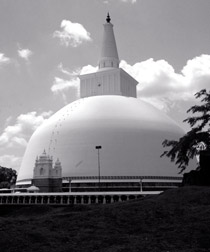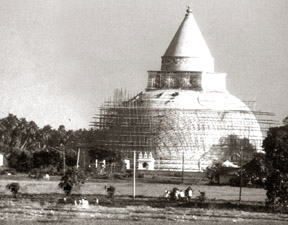|
observer |
|
|
|
|
|
OTHER LINKS |

|

|

|
Sacred architecture
The word dagoba is not, as sometimes assumed, completely interchangeable with stupa, for not all stupas are dagobas, i.e., they do not all contain a relic chamber. A secondary more hidden meaning of the word dagobas is derived from the usage of dhatu to mean 'element'. Nevertheless, it was originally a burial tumulus, a relatively small and simple mound of earth. Over time, though, it developed into a sophisticated and sometimes massive construction - with an equally complex symbolism - that contained a relic of the Buddha or one of the saints. Over a period of 2,000 years, dagobas have come to dominate the landscape. Indeed, one of Sri Lanka's more delightful aspects is the manner in which almost every rocky crag and discernible hill is graced with the milk-white hemisphere of a dagoba. That's apart from the usually bigger dagobas of the plains and lowlands - often set among vibrant green paddyfields - that seem to loom, shimmering starkly in the heat, round every corner of the road.
Styles changed over the centuries. The square railing surmounting the dome developed into a solid cube of brick. Above this rose a straight shaft crowned by one or a series of circular discs representing the honorific umbrella or chattra, a symbol of respect and authority. After the 7th century the open chattra turned into conical spires or pinnacles, which are found on all the dagobas in existence today. Such enormous structures required very high standards of construction. This was particularly so with the foundations, which have not sunk despite supporting the massive weight of the solid brick hemispheres for 2,000 years or more. The Mahawamsa tells how King Dutugemenu ordered the foundations of the Ruwanweliseya Dagoba to be built. According to the chronicle he had "rounded stones brought by means of his soldiers, had them well beaten down with pounders, and to ensure greater durability, he caused the layer of stones to be trampled by enormous elephants whose feet were protected by leather shoes. He had clay spread upon the layer of stones; over that a network of iron; over that a layer of phalikia stone, and over that he laid a course of common stone."
This cosmic symbolism can be found throughout the dagoba. The lower relic chamber is at ground level, the dome rising around and over it. Below the chamber is a small compartment containing a chank that symbolises the subterranean ocean. In the centre of the chamber stands a model of the Cosmic Mountain Meru, and beside it four stones representing the four continents. Meru is a mythic mountain that is the axis of the world in Hindu and Buddhist cosmology. Continents and oceans occur in concentric rings round Meru, while the stars encircle the mountain in another plane. It has been described as having jewel-bedecked gardens and palaces and being graced with celestial musicians. The continent to the south of Meru, is known as Jambudvipa, "the island of jambu (rose apple) trees," where humankind lives. On the chamber walls of the dagoba are painted figures of gods moving among the clouds of the lower heavens. The chamber therefore signifies the Middle World, which consists of the earth and atmospheric regions. On top of the model of Meru is placed a relic casket symbolizing the Buddha as 'Lord of the Worlds.' Above the chamber, at the apex of the dome, is another compartment that stands for the higher world or the various planes of existence hovering above Meru. As a result the dagoba is a precise and compact correlative of the manifest world in its entirety. When reduced to its fundamental form the dagoba is a square (the base) topped by circle (the dome). Furthermore, the square and circle conjoin at a sacred centre (the relic chamber). The dagoba is therefore the synchronization of the sphere and the circle, which happens to be the fundamental principle of the sacred architecture. This synchronization of square and circle, the two most ancient symbols of earth and heaven, is a universal sign of the transformation of matter into spirit, of death into life, of time into eternity. |

 You see them almost wherever you travel in Sri Lanka. Their stark
white hemispheres, crowned by an elegant spire, punctuate the landscape.
Dagobas are an essential element of the sacred architecture of Sri
Lanka, with a complex structure and deep symbolism. There is nowhere
better to witness them than at Anuradhapura, for it was in that city
where the art of dagoba building reached its zenith, producing some of
the largest structures on the planet... The pre-eminent form of Buddhist
architecture is the dagoba (also known as the stupa), which is basically
a dome crowned by a pinnacle standing on a square platform. The word
dagoba is a compound of dhatu ('element' or 'essence' and hence "a
sacred relic") and gharbha ('chamber' or 'cavern'). Therefore its
literal meaning is "a chamber for a sacred relic."
You see them almost wherever you travel in Sri Lanka. Their stark
white hemispheres, crowned by an elegant spire, punctuate the landscape.
Dagobas are an essential element of the sacred architecture of Sri
Lanka, with a complex structure and deep symbolism. There is nowhere
better to witness them than at Anuradhapura, for it was in that city
where the art of dagoba building reached its zenith, producing some of
the largest structures on the planet... The pre-eminent form of Buddhist
architecture is the dagoba (also known as the stupa), which is basically
a dome crowned by a pinnacle standing on a square platform. The word
dagoba is a compound of dhatu ('element' or 'essence' and hence "a
sacred relic") and gharbha ('chamber' or 'cavern'). Therefore its
literal meaning is "a chamber for a sacred relic."  There are six different types of dagoba dome in Sri Lanka, of which
the best known are the bubble, the bell, the paddy-heap and the lotus.
The oldest architectural form, and the most difficult to perfect, is the
bubble shape - that is, a bubble floating on water, the shape used in
the Ruwanweli Dagoba. These domes reached enormous proportions at
Anuradhapura, such as were unique in the Buddhist world. Anuradhapura
was the world's Buddhist headquarters and the dagoba was its symbol.
Only one Indian example, the Amaravati, 50 metres in diameter, could be
compared with those of Anuradhapura. When the Ruwanweli Dagoba was
built, it was the largest monument of its kind in the world with a
77-metre diameter. The later dagobas of the Abhayagiri and Jetavana
monasteries were even bigger, the Jetavana being 99 metres in diameter
and 122 metres tall, higher than St. Paul's cathedral, London.
There are six different types of dagoba dome in Sri Lanka, of which
the best known are the bubble, the bell, the paddy-heap and the lotus.
The oldest architectural form, and the most difficult to perfect, is the
bubble shape - that is, a bubble floating on water, the shape used in
the Ruwanweli Dagoba. These domes reached enormous proportions at
Anuradhapura, such as were unique in the Buddhist world. Anuradhapura
was the world's Buddhist headquarters and the dagoba was its symbol.
Only one Indian example, the Amaravati, 50 metres in diameter, could be
compared with those of Anuradhapura. When the Ruwanweli Dagoba was
built, it was the largest monument of its kind in the world with a
77-metre diameter. The later dagobas of the Abhayagiri and Jetavana
monasteries were even bigger, the Jetavana being 99 metres in diameter
and 122 metres tall, higher than St. Paul's cathedral, London.  More important than the physical aspects of the dagoba is its deep
symbolism. It is in essence a representation of the cosmos, to which the
Buddha's earthly body corresponds on a smaller scale. Hence the base
recalls the torso, the dome the head, and the pinnacle the protuberance
on the skull in most images that symbolises the super consciousness, the
spiritual wisdom of the Buddha, the Enlightened One.
More important than the physical aspects of the dagoba is its deep
symbolism. It is in essence a representation of the cosmos, to which the
Buddha's earthly body corresponds on a smaller scale. Hence the base
recalls the torso, the dome the head, and the pinnacle the protuberance
on the skull in most images that symbolises the super consciousness, the
spiritual wisdom of the Buddha, the Enlightened One. 






